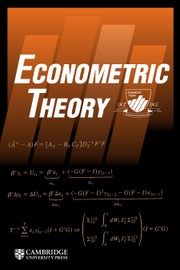Article contents
NEGATIVE VOLATILITY SPILLOVERS IN THEUNRESTRICTED ECCC-GARCH MODEL
Published online by Cambridge University Press: 26 October 2009
Abstract
This paper considers a formulation of the extendedconstant or time-varying conditional correlationGARCH model that allows for volatility feedback ofeither the positive or negative sign. In theprevious literature, negative volatility spilloverswere ruled out by the assumption that all theparameters of the model are nonnegative, which is asufficient condition for ensuring the positivedefiniteness of the conditional covariance matrix.In order to allow for negative feedback, we showthat the positive definiteness of the conditionalcovariance matrix can be guaranteed even if some ofthe parameters are negative. Thus, we extend theresults of Nelson and Cao (1992) and Tsai and Chan(2008) to a multivariate setting. For the bivariatecase of order one, we look into the consequences ofadopting these less severe restrictions and findthat the flexibility of the process is substantiallyincreased. Our results are helpful for themodel-builder, who can consider the unrestrictedformulation as a tool for testing various economictheories.
Information
- Type
- Research Article
- Information
- Copyright
- Copyright © Cambridge University Press 2009
Footnotes
For insightful suggestions and constructivecomments we thank Bruce E. Hansen, and twoanonymous referees. We would also like to thankLuc Bauwens, Tim Bollerslev, Charles Bos, MichaelBurmeister, James Davidson, Russell Davidson,Jurgen A. Doornik, Martin Gassebner, Siem JanKoopman, Michael J. Lamla, Bent Nielsen, MariusOoms, Ruey Tsay, and Giovanni Urga for theirvaluable suggestions. We have also benefited fromthe comments received from participants at theseminar held in the Department of Economics at theUniversity of Exeter in November 2007, theInaugural Conference of the Society for FinancialEconometrics (New York, 2008), the AnnualConference of the ESRC Econometric Study Group(Bristol, 2008), the 63rd EuropeanMeeting of the Econometric Society (Milan, 2008),the Oxford-Man Institute Financial Econometricsand Vast Data Conference (Oxford, 2008), and the7th OxMetrics User Conference (London,2008).
References
REFERENCES
- 55
- Cited by

